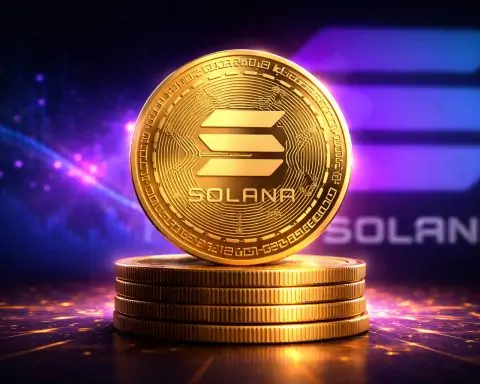- Pullback After Uptober Surge: Solana’s price (SOL) has retraced to the mid-$180s after soaring above $250 in early October – its highest level since January [1]. This drop to around $186–$195 marks a healthy breather following the rally, testing a crucial support zone [2]. SOL is still up dramatically year-to-date (from ~$50 last year), despite the recent volatility.
- Critical Support & Resistance: Analysts highlight $186–$195 as a make-or-break support range (aligned with Solana’s 200-day moving average) [3]. Holding above this level could spark a rebound toward the next resistance around $199–$210 (where the 50- and 100-day averages intersect) [4]. Clearing $210 would target $225–$230 next, according to chartists [5]. However, failure to hold support risks deeper retracement toward $172 or even $143 (key Fibonacci levels) [6] [7].
- Outflows & “Catch” to the Rally: Nearly $400 million worth of SOL flowed out from exchanges in the past few days, including $110M on Oct. 16 alone [8]. These persistent outflows signal heavy profit-taking and reduced short-term liquidity, which could limit any immediate recovery [9]. In other words, even though one technical “code” points to a potential rally back to ~$250, the catch is that waning liquidity and recent selling pressure may hinder a quick rebound.
- Institutional Bets and Network Strength: Big players continue to express confidence in Solana’s long-term value. VC giant Andreessen Horowitz (a16z) just injected $50 million into a Solana staking firm (Jito Foundation) to bolster the network’s infrastructure [10] [11]. Earlier this month, Nasdaq-listed Forward Industries raised $1.65B to buy ~6.8 million SOL (over 1% of total supply), pivoting its business into a “Solana treasury” [12]. Solana’s blockchain has also proven its chops under stress – during the recent crypto flash crash, it handled surging transaction volumes “with ease” while some rival networks struggled [13].
- Cautious Optimism in Forecasts: Many experts remain bullish but guarded. Bitwise CIO Matt Hougan lauds Solana’s “speed, throughput and near-instant finality,” even dubbing it “the new Wall Street” of tokenized finance [14]. Galaxy Digital CEO Mike Novogratz calls this crypto’s “season of SOL”, amid hopes a U.S. spot Solana ETF could launch soon [15] [16]. Some analysts predicted $300+ prices if an ETF is approved and new capital floods in [17] – JPMorgan estimates a Solana ETF could bring $1.5 billion of inflows [18]. Ultra-bullish cases even eye $500 in the next year or two [19]. However, after Solana’s wild swings, not everyone expects new highs immediately – e.g. recent prediction markets gave only ~41% odds of SOL hitting a fresh peak this year [20]. Macro risks also linger: last week, a surprise 100% tariff threat by the U.S. triggered a marketwide sell-off, knocking SOL from ~$222 to $184 in one day [21] [22].
Rally Stalls at “Uptober” Highs, Then a Healthy Reset
October started with a bang for Solana – the coin surged roughly 25% in early “Uptober,” briefly spiking above $250 around Oct. 6 [23]. That marked Solana’s strongest price since January and capped a massive run-up from its 2024 lows. The rally was fueled by broad crypto momentum and anticipation of Solana ETF approvals, along with big institutional buys. By mid-month, however, SOL lost steam. After peaking near $240–$250, it reversed sharply, slipping below $220 and even $200 as traders took profits [24] [25]. As of Oct. 17, Solana hovers in the high-$180s – roughly 17% below its early-month peak [26] [27].
Market analysts suggest this pullback is not inherently bearish. It looks like a natural cooling-off after Solana’s vertical rally. Crypto commentator BitGuru noted SOL entered a “healthy pullback phase” – essentially a chance to “recharge” after its burst of bullish momentum [28]. Such pauses often lay a foundation for more sustainable growth, rather than indicating weakness [29]. In fact, despite the recent dip, Solana’s overall market structure remains constructive, with buyers still active (if a bit cautious) following the volatility [30]. This resilience is why traders have nicknamed October as “Uptober” for SOL.
Notably, Solana’s network itself didn’t flinch during the market turbulence. The recent flash crash on Oct. 11 – triggered by geopolitical news – put many blockchains under strain. Solana, however, handled the tremendous surge in volume with ease, while some other networks (like Ethereum) showed signs of stress [31]. This performance under pressure has been cited by experts as a vote of confidence in Solana’s tech. “Solana’s high throughput and efficiency really shone when the market got wild,” observes Alex Carchidi of the Motley Fool [32], suggesting the network’s robustness is a reason some investors are buying the dip. In other words, Solana’s fundamentals – from fast transactions to growing DApp usage – remain intact, even as the price takes a breather.
Bulls Hold the Line at $195 – Or Risk a Deeper Dive
All eyes are now on the $190-ish support zone. Around $186–$195 is where Solana has been consolidating, and it’s a critical line in the sand. This level roughly corresponds to Solana’s 200-day exponential moving average – a long-term trend indicator – and the bottom of a symmetrical price pattern it’s been forming [33]. If the bulls defend this “lifeline”, analysts say Solana could mount a solid rebound. Crypto X (Twitter) trader BitGuru points out that as long as buyers hold above ~$190 and push through near-term resistance (~$210), SOL could quickly revisit $225–$230 in the short term [34]. Above that, a break past ~$240 would put the recent ~$250 high back in play – essentially completing the triangle and confirming a comeback rally.
However, the downside scenario looms if $186 fails. Charts show that a decisive breakdown below this support could open the trapdoor to $172 and even $143 [35]. Those levels correspond to key Fibonacci retracements of Solana’s 2025 rally, meaning a lot of previous buying interest sits there. In plain English: losing $186 might trigger another 15–20% drop before SOL finds a strong floor. For now, traders report that Solana is flirting with that danger zone – it briefly dipped to the mid-$180s on Oct. 17 amid broader market weakness.
Short-term momentum indicators have tilted bearish, reflecting this cooldown. SOL’s price has slipped below its 50-day and 100-day moving averages (now acting as resistance around $199–$208) [36]. It’s also been logging lower highs in the past week. Yet there are hints the sell-off is fading: one crypto analyst, BeLaunch, notes that Solana’s recent slide came on declining trading volumes, which “suggests selling pressure might be easing rather than intensifying” [37]. In his view, SOL is likely entering a consolidation phase – essentially moving sideways to form a base – “rather than a full trend reversal” [38]. The price action indeed looks like it’s forming a bottoming pattern after the big breakout run.
This leads to a cautiously hopeful outlook from chart watchers: “A sustained hold above $195 could trigger a rebound,” BeLaunch concludes, potentially allowing Solana to retest $210 and beyond [39]. In contrast, “a breakdown below this level could lead to a deeper retracement,” possibly into the $170s [40]. Importantly, he adds that even if SOL does slip further, the broader trend may still be bullish – the current dip looks more like a “healthy reset within a larger uptrend,” not the start of a prolonged downtrend [41]. In other words, unless Solana were to collapse well below its prior lows, many analysts see this pullback as a pit stop, not a U-turn.
Big Money Backs Solana – Institutional Inflows vs. Outflows
One of the most striking dynamics in Solana’s recent saga is the duel between smart money inflows and short-term trader outflows. On one hand, on-chain data indicates that over the last 72 hours, nearly $400 million worth of SOL has been pulled off exchanges [42]. Typically, heavy exchange outflows accompany either long-term holding (bullish) or, in the current context, profit-taking after a rally. In this case, analysts believe it’s largely the latter: many traders who bought Solana earlier in the uptick appear to be locking in gains. Coinglass data showed $110M withdrawn on Oct. 16 alone [43]. Such persistent withdrawals “suggest…reduced short-term liquidity” for SOL [44] – meaning fewer coins available to buy on exchanges and potentially less fuel for an immediate bounce. In essence, this is the “catch” tempering Solana’s rebound prospects: bulls have less ammo in the near term as some capital has rotated out.
On the other hand, long-term institutional bets on Solana are only growing. Even as retail traders lighten positions, major investors and firms are doubling down on the blockchain’s future. Just this week, famed venture fund Andreessen Horowitz (a16z) provided a $50 million lifeline to a Solana-focused project [45] [46]. The funding round – for Jito Foundation, which builds Solana staking and validator tech – is aimed at supercharging Solana’s infrastructure. According to Jito, the cash will help expand its open-source validator systems and its liquid staking token (JitoSOL) that already represents $3.2B in staked value [47] [48]. A16z’s crypto chief expressed that this investment “isn’t just about scaling… it’s about helping everyone on Solana extract more value” while improving transparency on the network [49]. In plainer terms, one of Silicon Valley’s top VC firms just made a significant vote of confidence in Solana’s ecosystem – even as prices slumped, they’re funding future growth.
And a16z is far from alone. In late September, a tiny publicly-traded company Forward Industries (FORD) shocked Wall Street by revealing a pivot to become a “Solana holding company.” It raised $1.65 billion solely to acquire SOL tokens – roughly 6.8 million SOL, about 1.3% of the total supply – and staked a large portion for yield [50]. This bold move sent Forward’s stock price rocketing 500% in days [51]. Around the same time, Web3 firm Helius (soon to rebrand as “Solana Company”) disclosed it bought ~2.2 million SOL for its treasury [52]. Even crypto heavyweight Galaxy Digital reportedly transferred the equivalent of ~$724M of SOL from exchanges into custody, presumably preparing for new Solana-based funds or products [53]. These are massive positions that signal strong conviction in Solana’s long-term value.
Beyond direct token purchases, Solana’s usage metrics reinforce why institutions are intrigued. The network boasts 1–3 million daily active addresses (far exceeding what early Ethereum had) and around $30B in total value locked in its DeFi applications [54]. Developers are active too – Solana has been “among the top ecosystems for developer commits in 2025,” indicating lots of building is happening [55]. And adoption keeps expanding: for example, the popular fantasy sports NFT platform Sorare is migrating 5 million user accounts to Solana by the end of this month, and fintech firm Circle recently launched a $635M tokenized U.S. Treasuries fund on Solana [56]. All these fundamental indicators underscore that Solana’s ecosystem is growing even as its price gyrates.
“Solana is extraordinarily attractive,” argues Matt Hougan, CIO of Bitwise Asset Management, “because of its speed, throughput, and near-instant finality.” Hougan even calls Solana “the new Wall Street” for its potential to host mainstream financial markets via tokenization [57]. That sentiment – comparing Solana’s high-performance blockchain to a next-gen Nasdaq – helps explain the fervor behind these big investments. It’s a narrative of technological edge: Solana can handle high-frequency trading and complex apps in a way that some older chains struggle with. This week’s $50M a16z deal for Jito is a direct play to capitalize on that edge by making Solana’s core even faster and more efficient.
Outlook: Path to $250+ if Catalysts Fire – But Caution Remains
Going forward, Solana’s fortunes may hinge on a few key catalysts and whether bulls can maintain momentum amid a choppy broader market. In the optimistic scenario, if SOL holds its support and positive news hits, a rally back to the $240–$250 range is within reach, potentially quite fast. In fact, some technicians see the recent price pattern as coiled spring: a symmetrical triangle whose upper trendline sits around $250. A breakout above SOL’s recent highs could “unlock” a move toward that $250–$253 zone (approximately a 30% jump from current prices) – essentially re-testing the early October peak. This aligns with that idea of Solana’s “code” or setup pointing to a $253 rally target. But importantly, as Benzinga’s Parshwa Turakhiya quips, “there’s a catch.” For that upside to materialize, bulls must preserve the support floor (no breakdown) and preferably see a reversal of those exchange outflows into new inflows [58] [59]. Without fresh buying volume, any breakout attempt could fizzle.
One anticipated catalyst was the SEC’s decision on spot Solana ETFs, expected around Oct. 10–16. Crypto markets had been buzzing that U.S. regulators might approve the first-ever SOL-backed exchange-traded funds – Bloomberg analyst Eric Balchunas even tweeted that the odds felt “really 100%” after recent rule changes [60]. Such approval would open the floodgates for institutional money to pour into SOL. However, as of Oct. 17, no announcement has come. (Some reports suggest the SEC may delay decisions, especially given other regulatory distractions.) The lack of an immediate green light took a bit of wind out of bulls’ sails this week. Still, many believe it’s a question of “when,” not “if” a Solana ETF launches. JPMorgan projects roughly $1.5 billion of demand could flow into Solana if a U.S. spot ETF goes live [61] – a major tailwind for price if it materializes.
Top crypto investors remain guardedly bullish. Mike Novogratz, who runs Galaxy Digital, has proclaimed this season the “Season of SOL” – suggesting Solana is at the forefront of the market’s attention [62]. He and others note that new fund flows appear to be rotating into Solana and a few other tokens (like Binance’s BNB), whereas Ethereum’s big run-up may be taking a breather [63]. Some traders on social media have even argued SOL might be a “stronger bet” than ETH in the short term, given how much hype and capital is zeroing in on Solana’s ecosystem [64]. This sentiment, combined with the concrete developments (ETFs, institutional buys, network growth), underpins a plethora of rosy price forecasts. For instance, various chart analysts in early October set targets around $300–$330 for SOL if the rally resumed with force [65]. One TS2.Tech report compiled predictions of ~$312 by late October, and even ~$345 if momentum persists [66]. Looking further out, some forecasters who a year ago boldly envisioned “SOL to $500” by 2025 now see that as increasingly plausible [67] – especially since SOL already made an almost 5× move from its lows into this month.
That said, prudent voices emphasize risk management. Solana’s impressive 2025 run (+300% or more from January) has come with extremely high volatility. The events of October 11 were a stark reminder: a single unexpected geopolitical headline (President Trump threatening new China tech tariffs) caused a flash crash that erased 15% of SOL’s value in 24 hours [68] [69]. Such swings can quickly derail even the most bullish technical setups. Additionally, macro factors like U.S. interest rate moves or shifts in overall crypto sentiment could impact Solana. It’s worth noting that, according to one analysis, the probability of Solana hitting a new all-time high (above ~$260) by the end of 2025 was only around 40% as of last month [70]. That implies the market is cautiously optimistic but not fully convinced of unfettered upside.
Bottom line: Solana has entered a pivotal moment – holding the ~$195 support could confirm that this month’s dip was just a pit stop before the next leg higher. In that scenario, SOL’s ambitious community will be cheering for a return to $250 and beyond, potentially riding on forthcoming catalysts like an ETF approval or continued institutional accumulation. But if the support falters, Solana may spend longer in the woods, possibly sliding toward the $170s in search of a stronger bottom. For now, bulls and bears are in a tense standoff at Solana’s “lifeline” price. Given Solana’s solid fundamentals and the high hopes riding on it, many investors are watching this level as the launchpad – or the trapdoor – for the next big move in SOL. As one crypto observer quipped, “At $195, Solana’s either gearing up for a comeback or taking a final bow – and the next few days will tell us which.” [71] [72]
Sources: Solana technical analysis and expert commentary [73] [74] [75] [76]; Benzinga/Coinpaper market update [77] [78]; TS2.Tech Solana report (Oct 12) [79] [80]; NewsBTC market coverage [81] [82]; CoinDesk/CoinTelegraph via TS2.Tech [83] [84].
References
1. ts2.tech, 2. www.newsbtc.com, 3. www.benzinga.com, 4. www.benzinga.com, 5. www.newsbtc.com, 6. www.benzinga.com, 7. www.benzinga.com, 8. www.benzinga.com, 9. www.benzinga.com, 10. www.benzinga.com, 11. www.benzinga.com, 12. ts2.tech, 13. finance.yahoo.com, 14. ts2.tech, 15. ts2.tech, 16. ts2.tech, 17. ts2.tech, 18. ts2.tech, 19. ts2.tech, 20. ts2.tech, 21. ts2.tech, 22. ts2.tech, 23. ts2.tech, 24. ts2.tech, 25. ts2.tech, 26. ts2.tech, 27. ts2.tech, 28. www.newsbtc.com, 29. www.newsbtc.com, 30. www.newsbtc.com, 31. finance.yahoo.com, 32. finance.yahoo.com, 33. www.benzinga.com, 34. www.newsbtc.com, 35. www.benzinga.com, 36. www.benzinga.com, 37. www.newsbtc.com, 38. www.newsbtc.com, 39. www.newsbtc.com, 40. www.newsbtc.com, 41. www.newsbtc.com, 42. www.benzinga.com, 43. www.benzinga.com, 44. www.benzinga.com, 45. www.benzinga.com, 46. www.benzinga.com, 47. www.benzinga.com, 48. www.benzinga.com, 49. www.benzinga.com, 50. ts2.tech, 51. ts2.tech, 52. ts2.tech, 53. ts2.tech, 54. ts2.tech, 55. ts2.tech, 56. ts2.tech, 57. ts2.tech, 58. www.benzinga.com, 59. www.benzinga.com, 60. ts2.tech, 61. ts2.tech, 62. ts2.tech, 63. ts2.tech, 64. ts2.tech, 65. ts2.tech, 66. ts2.tech, 67. ts2.tech, 68. ts2.tech, 69. ts2.tech, 70. ts2.tech, 71. www.newsbtc.com, 72. www.benzinga.com, 73. www.newsbtc.com, 74. www.newsbtc.com, 75. www.benzinga.com, 76. www.benzinga.com, 77. www.benzinga.com, 78. www.benzinga.com, 79. ts2.tech, 80. ts2.tech, 81. www.newsbtc.com, 82. www.newsbtc.com, 83. ts2.tech, 84. ts2.tech










